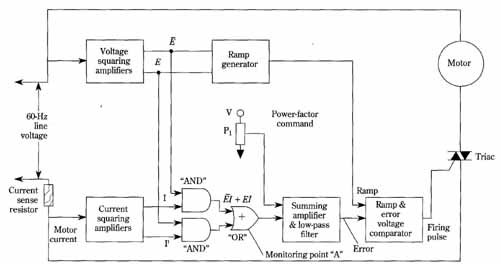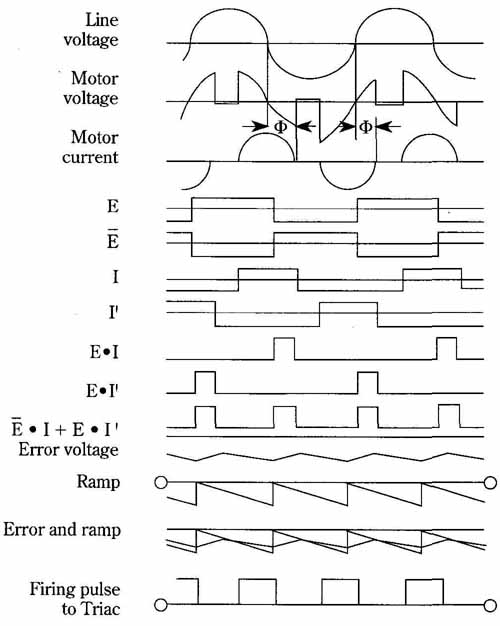AMAZON multi-meters discounts AMAZON oscilloscope discounts
The previous sections dealt with basic principles of various electric motors and with detailed circuit techniques for controlling them. Once insight has been at tamed with regard to the operation and performance of the different types of motors, it becomes feasible to treat the topic of electronic control lit a more streamlined fashion. Accordingly, this section presents examples of electronic control for a variety of electric motors, but under the assumption that you no longer require a detailed “how- to” approach. This makes sense because individual performance requirements can be expected to differ widely. Also, it’s generally true that the “classical” behavior of the various motors no longer prevails after applications of the electronic control.
Energy conservation via power factor control
Next to the electric lamp, the induction motor has contributed greatest to the modern lifestyle associated with the age of electricity. In particular, the single-phase type is the prime mover behind a wide variety of appliances, pumps, and mechanized tools. Until recently, relatively little has been done to alter the performance of induction motors. Indeed, its ability to maintain speed and torque in the face of both voltage and load variations has long been hailed as its most desirable feature. Over looked, at least until the advent of society’s “energy crunch,” has been the lamentably poor efficiency of these motors at light loads. And prior to a clever electronic invention, the general notion was that virtually nothing could be done to alleviate this drawback.
The fully loaded induction motor consumes line current that is nearly in phase with the impressed voltage. With the power factor thereby close to unity, the operating efficiency of the motor is reasonably good. But, at light loads, the situation is quite different—for then there is considerable phase-lag between current and volt age. Because of this low power factor, the actual magnitude of the consumed current remains high. This causes much greater loss in both the motor and the line than would prevail if, somehow, better phase conditions could be restored. Of course, in such a situation, the magnitude of the current would decrease to comply with the low torque demand of the light load. In order to bring this desirable situation about, start by sensing the power factor of the line supplying the motor, and then vary an operating parameter that will affect the phase relationship.
Fortunately, it’s only necessary to reduce applied voltage in order to improve the phase condition of the lightly loaded motor. Indeed, this approach enables restoration of the power factor to approximately its fully loaded value. In actual practice, this must be done automatically in such a manner that the motor always operates at a high power factor (voltage and current nearly in phase) for any load condition.
FIG. 1 is a block diagram of a simple electronic system for maintaining a high power factor. By its use, the energy cost of running induction motors in some applications can be lowered by as much as 40 percent.
In the block diagram of FIG. 1, the several linear and digital functions can be implemented by a variety of op amps, transistors, diodes, and gates. One of the main objectives is to produce pulses, the width of which are proportional to the phase angle between line voltage and motor current. This important pulse train is shown in the waveform diagram of FIG. 2 as the logical format E.I + El’ and is present in the block diagram at point “A.” Note that 0 represents the phase angle between line voltage and motor current, and is the sensed parameter in the control system. The sensing of 0 and the subsequent production of width-modulated pulses at point “A” can be said to be the electronic heart of the control technique. This cause-and-effect relationship then actuates subsequent circuitry, which controls the voltage applied to the motor (the waveforms are idealized to simplify the basic discussion).
Initially, the voltage applied to the motor and the current consumed by the mo tor are applied to overdriven op amps in order to produce waveforms E, and 1,1’. The current waveforms are the consequence of sensing the voltage drop across the current-sense resistor, which is of very low value in order not to effect motor performance or develop appreciable dissipation. The logic gates then are employed to AND E with I, and E with I’, thence O Ring the result. This gives the desired pulses having widths proportional to the power-factor angle THETA.
Actually, a pair of op amps are used in both the voltage-squaring, and in the cur rent-squaring functions inasmuch as two voltage waveforms and two current wave forms must be derived for presentation to the logic gates. From the waveform diagram of FIG. 2 the individual amplifiers of the respective pairs can be seen to develop 180° displaced outputs.
The next objective of this control system is to use the pulse train at “A” to vary the effective voltage applied to the motor. The basic idea is to automatically lower the effective motor voltage when the power factor is low, that is, when the motor is lightly loaded. This accomplishment will, in turn, greatly increase the light load power factor. This important result occurs because only then can the motor, operating with reduced voltage, accommodate its load. The improved power factor will be accompanied by reduced motor current. Thus, the control function merely deprives the motor of voltage when the sensed power factor is low (corresponding to light load). Thereafter, the motor adjusts its operation from low power factor and high current to the more efficient format of high power factor and low current. Let us now see how the motor voltage is reduced in response to the low power factor condition.

FIG. 1 Block diagram of the power-factor control system for induction
motors. Systems operates to lower applied voltage to motor at low power-factors.
This, in turn, tends to correct the power factor and increase the efficiency
of the motor. Monitoring point “A” is explained in the text.
We will now deal with the subsequent circuitry (the circuit functions following point “A” on the block diagram). The width-modulated pulses are fed to an active low- pass filter, or integrator. In this manner, a near-dc voltage is developed that is proportional in magnitude to the phase angle E The active low-pass filter also performs as a summing amplifier, accommodating an adjustable dc voltage on one of its inputs. This adjustment is the power-factor command. It enables optimum performance to be attained for the load circumstances under which a particular motor operates.
The near dc output voltage from the low-pass filter, together with a line-synchronized ramp voltage, are applied to the input terminals of a voltage comparator. The output pulses from the voltage comparator are thereby position modulated, or timed, by the amplitude of this dc voltage (the error voltage in FIG. 2). This dc voltage represents phase-angle theta, that is the power factor. Finally, by using the voltage-comparator output pulses (bottom waveform, FIG. 2) to trigger the triac, the effective voltage applied to the motor can be controlled much in the manner of ordinary light- dimmer circuits. More specifically, low power factor will cause delayed firing of the triac, thereby reducing motor voltage. As previously explained, this causes the mo tor to reduce its current and to increase its power factor. These, of course, are the requisites for efficient operation.

FIG. 2 Waveform diagram pertaining to the power-factor controller.
In response to power-factor angle, Theta, the pulse-train, E.I + E.I’
is developed. Then, the average value of these pulses, together with
a line-synchronized voltage-ramp, controls the timing of triac gate-pulses.
Thus, at low power-factor motor voltage is lowered.
Several side effects of such electronically controlled power factor can be mentioned. Because of cooler operation from lower current demand at light loads, motor longevity is enhanced. In industrial installations where many small motors, or fewer large ones, are used the penalty often imposed by power companies for low power factor can be avoided. The light-load speed reduction from reduced voltage will generally be of negligible amount, say on the order of two percent or less. Also, the concept is applicable to three-phase motors. The idea is to sense e in one phase, but to use the error voltage to control triac triggering in all three phases. Because of unique circuit requirements imposed by various polyphase arrangements with regard to delta, Y, and neutral connections, some ingenuity might be required for successful implementation.
The circuit shown in FIG. 3 is applicable to many single-phase fractional horse power induction motors. Correspondences with the block diagram of FIG. 1 are as follows:
The voltage-squaring amplifiers are op amps IC1A and 1dB. The current-squaring amplifiers are op amps IC1C and IC1D. Diodes D1 and D2, together with their resistance networks perform the logic operations. IC2A is the summing amplifier and low-pass filter. The power-factor command adjustment is provided by potentiometer P1. The line-synchronized ramp generator is the 2N2907 pnp transistor. up amp IC2B functions as the ramp and error-voltage comparator. A driver triac is used ahead of the actual motor-control triac. Two simple half-wave power supplies pro duce the required plus and minus 15 volts. They are regulated by zener diodes.
The IC2C circuitry is not referred to in the block diagram and has not been mentioned in the discussion of operating theory. This is an auxiliary circuit that delays triggering of the triacs for several seconds after the system is first turned on. It pre vents an initial current surge tending to occur because the 15-volt supplies don’t become immediately operational.
The op amps can be LM324s in which case IC2D of these quadruple units is not used. TR1, the motor-drive triac is a 25-ampere, 400-volt type, such as the 2N6 161. This triac will need to be heatsinked.
The power factor controller is a government-owned invention, but licenses for commercial development are available at no charge. Further information can be obtained from the Technology Utilization Office of the Marshall Space Flight Center, Administration and Support Division, Marshall Space Flight Center, Alabama 35812.
The peculiar shape of the motor voltage waveform merits special mention. Be cause of the inductance of the motor’s stator winding, the voltage applied to the stator and the resultant stator current are considerably out of phase. More specifically, the stator current lags the stator voltage. Once a triac is triggered into conduction, such conduction does not cease until the current through the triac passes through zero. This is true even though the voltage across the triac is reduced to zero (the current is the governing parameter). With lamps, or other resistive loads, both cur rent and voltage pass through their zero values together, so it might appear that zero voltage is the cause of the triac going out of conduction. Despite the notches thereby produced in the motor current waveform, operation and control are essentially as good as would be the case with a more ideal voltage wave developed across the motor.


FIG. 3 Circuit for the power-factor controller for fractional-horsepower
induction motors. Triac TR1 can be typically a 400-volt, 25-ampere unit,
much as the 2N6161. A heatsink is required for most applications.